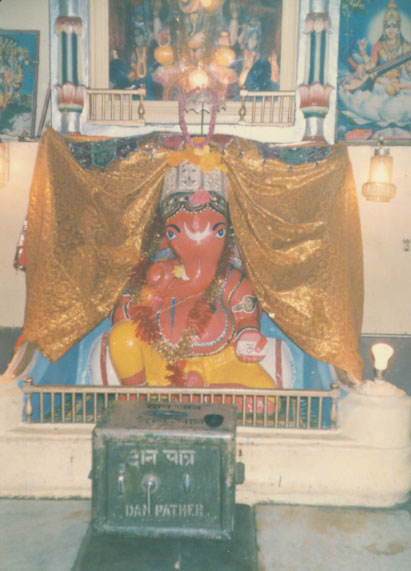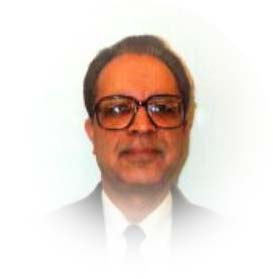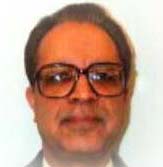Hindu Deities
Just as a single
force in space can be mathematically conceived as  having
various spatial
components, the Supreme Being or God, the personal form of the Ultimate
Reality, is conceived by Hindus as having various aspects. A Hindu deity
(god or goddess; note small g) represents a particular aspect of the Supreme
Being. For example, Saraswati represents the learning and knowledge aspect
of the Supreme Being. Thus, if a Hindu wants to pray for acquiring knowledge
and understanding, he prays to Saraswati. Just as sunlight cannot have
a separate and independent existence from the sun itself, a Hindu deity
does not have a separate and independent existence from the Supreme Being.
Thus, Hindu worship of deities is monotheistic polytheism and not
simple polytheism. having
various spatial
components, the Supreme Being or God, the personal form of the Ultimate
Reality, is conceived by Hindus as having various aspects. A Hindu deity
(god or goddess; note small g) represents a particular aspect of the Supreme
Being. For example, Saraswati represents the learning and knowledge aspect
of the Supreme Being. Thus, if a Hindu wants to pray for acquiring knowledge
and understanding, he prays to Saraswati. Just as sunlight cannot have
a separate and independent existence from the sun itself, a Hindu deity
does not have a separate and independent existence from the Supreme Being.
Thus, Hindu worship of deities is monotheistic polytheism and not
simple polytheism.
Hindus declare that there is only one Supreme
Being and He is the God of all religions. There is no "other God." Thus
the Biblical Commandment "Thou shalt have no other God before me," really
means, "Thou shalt not deny the Ultimate Reality or worship any power other
than the Ultimate Reality."
Hindus view cosmic activity of the Supreme Being
as comprised of three tasks: creation, preservation, and dissolution and
recreation. Hindus associate these three cosmic tasks with the three deities,
Brahma, Vishnu and Shiva. Lord Brahma brings forth the creation and represents
the creative principle of the Supreme Being. Lord Vishnu maintains the
universe and represents the eternal principle of preservation. Lord Shiva
represents the principle of dissolution and recreation. These three deities
together form the Hindu Trinity.
One must clearly understand that Brahma, Vishnu
and Shiva are not three independent deities. They represent the same power
(the Supreme Being), but in three different aspects. Just as a man may
be called a doctor, father or husband based upon the tasks he performs,
the Supreme Being is called Brahma, Vishnu or Shiva when conceived as performing
the three different cosmic tasks of creation, preservation, and dissolution/recreation.
"The oneness of the three gods Brahma, Vishnu and Shiva is brought out
by the mystic symbol AUM where 'A' represents Vishnu, 'U' Shiva
and 'M' Brahma."
Hindu religion is often labeled as a religion
of 330 million gods. This misunderstanding arises when people fail to grasp
the symbolism of the Hindu pantheon. According to the Hindu scriptures,
living beings are not apart from God, since He lives in each and every
one of them in the form of atman (BG 10.39). Thus each living being is
a unique manifestation of God. In ancient times it was believed that there
were 330 million living beings. This gave rise to the idea of 330 million
deities or gods. Actually, this vast number of gods could not have been
possibly worshipped, since 330 million names could not have been designed
for them. The number 330 million was simply used to give a symbolic
expression to the fundamental Hindu doctrine that God lives in the hearts
of all living beings.

- Bansi Pandit
 Lord
Brahma Lord
Brahma
Lord
Brahma symbolizes the aspect of the Supreme Reality that brings
forth the creation. For this very reason, Hindus call Lord
Brahma the Creator of the universe. He is the first member of
the Hindu Trinity that also includes Lord Vishnu and Lord Shiva.
>>>
|
|
 Goddess
Durga Goddess
Durga
Goddess
Durga represents the power of the Supreme Being that preserves
moral order and righteousness in the creation. The Sanskrit word
Durga means a fort or a place that is protected and thus
difficult to reach. >>>
|
|
|
|
The
Hindu deity in a human form but with the head of an elephant -
represents the power of the Supreme Being that removes obstacles
and ensures success in human endeavors.
>>>
|
|
 Hanuman Hanuman
Hanuman,
the great monkey hero, also called Maruti, assists Rama in his
battle with Ravana to rescue Sita, who had been kidnapped by
Ravana. Hanuman symbolizes the qualities of an ideal devotee of
God. >>>
|
|
|
|
 Goddess
Lakshmi Goddess
Lakshmi
Lakshmi
is the Goddess of wealth and prosperity, both material and
spiritual. The word ''Lakshmi'' is derived from the Sanskrit
word Laksme, meaning "goal." Lakshmi, therefore,
represents the goal of life, which includes worldly as well as
spiritual prosperity.
>>>
|
|
 Radha
and Krishna Radha
and Krishna
Lord
Krishna is the eighth and the most popular incarnation of Lord
Vishnu. He was born in approximately 3200 BCE in Vrindavan,
where he was brought up by the cowherd family of Yashoda and
Nanda. >>>
|
|
|
|
 Goddess
Saraswati Goddess
Saraswati
Saraswati
is the Goddess of leaming, knowledge, and wisdom. The Sanskrit
word sara means "essence" and swa means
"self." Thus Saraswati means "the essence of the
self." >>>
|
|
 Sita,
Rama, Lakshmana Sita,
Rama, Lakshmana
Lord
Rama is the seventh incarnation of Lord Vishnu. The worship of
Lord Rama is very popular among all Hindus, as is evident by the
numerous temples dedicated to him in India. >>>
|
|
|
|
 Sharda
Mata Temple at Gushi, Kupwara Sharda
Mata Temple at Gushi, Kupwara
It is situated on
the bank of Kishanganga
(now in Pakistan-occupied Kashmir) famous throughout the
country before partition. This is considered as a
"Siddha Peetha" like Sharika Chakreshwar
temple at Hari Parbat.
>>>
|
|
 Lord
Shiva Lord
Shiva
Lord
Shiva represents the aspect of the Supreme Being (Brahman of the
Upanishads) that continuously dissolves to recreate in the
cyclic process of creation, preservation, dissolution and
recreation of the universe. >>>
|
|
|
|
 Mata
Tripori Sondari Devi Mata
Tripori Sondari Devi
Goddess
Tripore Sondari is the main Shakti without which Shiv is "Shuni".
The detailed description of this Goddess has been given in
"Sunderlahri".
>>>
|
|
 Lord
Vishnu Lord
Vishnu
Lord
Vishnu represents the aspect of the Supreme Reality that
preserves and sustains the universe. Although there are
variations in images and pictures of Lord Vishnu, He is
generally symbolized by a human body with four arms. >>>
|
|
|
|
 Shiva
Bhagwati - (Akingam, Anantnag) >>> Shiva
Bhagwati - (Akingam, Anantnag) >>>
|
|
 Mata
Shakti >>> Mata
Shakti >>>
|
 Bansi Pandit Bansi Pandit
Bansi Pandit is a nuclear
engineer by profession. He has been a student of Vedanta and has
been associated with the Vivekananda Vedanta Society since his college
years. In 1981, he joined the Self-Realization Fellowship (founded
in the United States by Parmahansa Yogãnanda) . >>>
|
|
 Hindu
Dharma Hindu
Dharma
by Bansi Pandit
Hindu Dharma explains the
symbolism of the Hindu deities and includes nine beautiful color pictures
of the popular Hindu deities. These pictures can be used for daily puja
(worship) in the home shrines by the devotees.
>>>
|
|









 having
various spatial
components, the Supreme Being or God, the personal form of the Ultimate
Reality, is conceived by Hindus as having various aspects. A Hindu deity
(god or goddess; note small g) represents a particular aspect of the Supreme
Being. For example, Saraswati represents the learning and knowledge aspect
of the Supreme Being. Thus, if a Hindu wants to pray for acquiring knowledge
and understanding, he prays to Saraswati. Just as sunlight cannot have
a separate and independent existence from the sun itself, a Hindu deity
does not have a separate and independent existence from the Supreme Being.
Thus, Hindu worship of deities is monotheistic polytheism and not
simple polytheism.
having
various spatial
components, the Supreme Being or God, the personal form of the Ultimate
Reality, is conceived by Hindus as having various aspects. A Hindu deity
(god or goddess; note small g) represents a particular aspect of the Supreme
Being. For example, Saraswati represents the learning and knowledge aspect
of the Supreme Being. Thus, if a Hindu wants to pray for acquiring knowledge
and understanding, he prays to Saraswati. Just as sunlight cannot have
a separate and independent existence from the sun itself, a Hindu deity
does not have a separate and independent existence from the Supreme Being.
Thus, Hindu worship of deities is monotheistic polytheism and not
simple polytheism.












 Lord
Vishnu
Lord
Vishnu Shiva
Bhagwati - (Akingam, Anantnag)
Shiva
Bhagwati - (Akingam, Anantnag) 
 Bansi Pandit
Bansi Pandit




